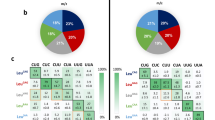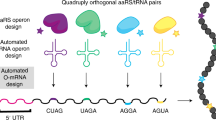Abstract
Engineered orthogonal translation systems have greatly enabled the expansion of the genetic code using noncanonical amino acids (NCAAs). However, the impact of NCAAs on organismal evolution remains unclear, in part because it is difficult to force the adoption of new genetic codes in organisms. By reengineering TEM-1 β-lactamase to be dependent on a NCAA, we maintained bacterial NCAA dependence for hundreds of generations without escape.
This is a preview of subscription content, access via your institution
Access options
Subscribe to this journal
Receive 12 print issues and online access
$259.00 per year
only $21.58 per issue
Buy this article
- Purchase on Springer Link
- Instant access to full article PDF
Prices may be subject to local taxes which are calculated during checkout


Similar content being viewed by others
References
Wong, J.T. Proc. Natl. Acad. Sci. USA 80, 6303–6306 (1983).
Rovner, A.J. et al. Nature 518, 89–93 (2015).
Mandell, D.J. et al. Nature 518, 55–60 (2015).
Lemeignan, B., Sonigo, P. & Marlière, P. J. Mol. Biol. 231, 161–166 (1993).
Chin, J.W. et al. J. Am. Chem. Soc. 124, 9026–9027 (2002).
Wang, J., Xie, J. & Schultz, P.G. J. Am. Chem. Soc. 128, 8738–8739 (2006).
Xie, J., Supekova, L. & Schultz, P.G. ACS Chem. Biol. 2, 474–478 (2007).
Liu, C.C. & Schultz, P.G. Annu. Rev. Biochem. 79, 413–444 (2010).
Hammerling, M.J. et al. Nat. Chem. Biol. 10, 178–180 (2014).
Bacher, J.M., Bull, J.J. & Ellington, A.D. BMC Evol. Biol. 3, 24 (2003).
Bacher, J.M. & Ellington, A.D. J. Bacteriol. 183, 5414–5425 (2001).
Wang, Q. et al. ChemBioChem 15, 1744–1749 (2014).
Kato, Y. PeerJ 3, e1247 (2015).
Cooley, R.B. et al. Biochemistry 53, 1916–1924 (2014).
Sakamoto, K. et al. Structure 17, 335–344 (2009).
Ohtake, K. et al. Sci. Rep. 5, 9762 (2015).
Bradford, P.A. Clin. Microbiol. Rev. 14, 933–951 (2001).
Fonzé, E. et al. Acta Crystallogr. D Biol. Crystallogr. 51, 682–694 (1995).
Baba, T. et al. Mol. Syst. Biol. 2, 2006.0008 (2006).
Lajoie, M.J. et al. Science 342, 357–360 (2013).
Thyer, R., Robotham, S.A., Brodbelt, J.S. & Ellington, A.D. J. Am. Chem. Soc. 137, 46–49 (2015).
Gibson, D.G. et al. Nat. Methods 6, 343–345 (2009).
Hashimoto-Gotoh, T. et al. Gene 241, 185–191 (2000).
Chung, C.T., Niemela, S.L. & Miller, R.H. Proc. Natl. Acad. Sci. USA 86, 2172–2175 (1989).
Stec, B., Holtz, K.M., Wojciechowski, C.L. & Kantrowitz, E.R. Acta Crystallogr. D Biol. Crystallogr. 61, 1072–1079 (2005).
Labute, P. Proteins 75, 187–205 (2009).
Labute, P. J. Chem. Inf. Model. 50, 792–800 (2010).
Clark, A.M. & Labute, P. J. Chem. Inf. Model. 47, 1933–1944 (2007).
Acknowledgements
This work was supported by the following grants: National Security Science and Engineering Faculty Fellowship grant FA9550-10-1-0169 to A.D.E. Welch Foundation grant F-1654. Defense Advanced Research Projects Agency N66001-14-2-4051 to A.D.E. Air Force Office of Scientific Research grant FA9550-14-1-0089 to A.D.E. Defense Advanced Research Projects Agency HR0011-15-C0095 to A.D.E.
Author information
Authors and Affiliations
Contributions
D.S.T. designed and performed experiments and wrote the manuscript. J.W.E. designed experiments and wrote the manuscript. R.T. designed experiments and wrote the manuscript. B.W. screened TEM-1 variants. M.T.F. screened TEM-1 variants. J.G. performed computational analysis using the Molecular Operating Environment. A.D.E. directed experimental work and wrote the manuscript.
Corresponding author
Ethics declarations
Competing interests
The authors declare no competing financial interests.
Supplementary information
Supplementary Text and Figures
Supplementary Results, Supplementary Figures 1–14 and Supplementary Tables 1–7. (PDF 1913 kb)
Source data
Rights and permissions
About this article
Cite this article
Tack, D., Ellefson, J., Thyer, R. et al. Addicting diverse bacteria to a noncanonical amino acid. Nat Chem Biol 12, 138–140 (2016). https://doi.org/10.1038/nchembio.2002
Received:
Accepted:
Published:
Issue Date:
DOI: https://doi.org/10.1038/nchembio.2002
This article is cited by
-
Exploring complexity of class-A Beta-lactamase family using physiochemical-based multiplex networks
Scientific Reports (2023)
-
A robust yeast biocontainment system with two-layered regulation switch dependent on unnatural amino acid
Nature Communications (2023)
-
Auxotrophy to Xeno-DNA: an exploration of combinatorial mechanisms for a high-fidelity biosafety system for synthetic biology applications
Journal of Biological Engineering (2018)
-
Evolving Bacterial Fitness with an Expanded Genetic Code
Scientific Reports (2018)
-
Custom selenoprotein production enabled by laboratory evolution of recoded bacterial strains
Nature Biotechnology (2018)



